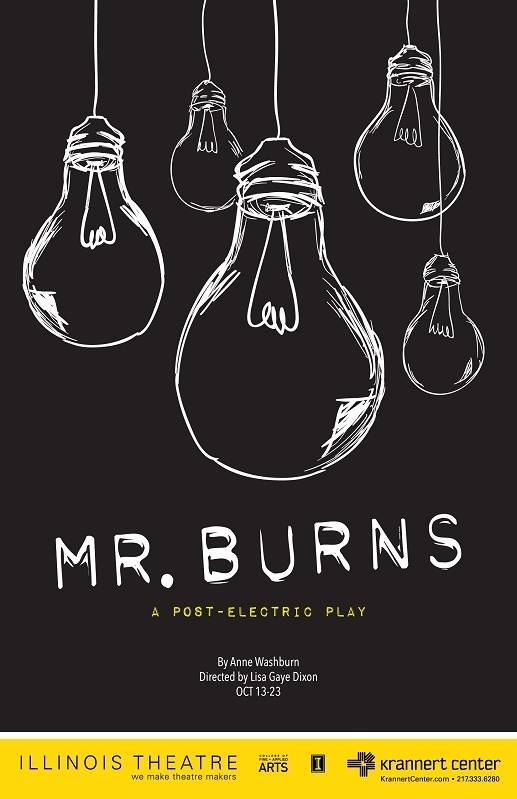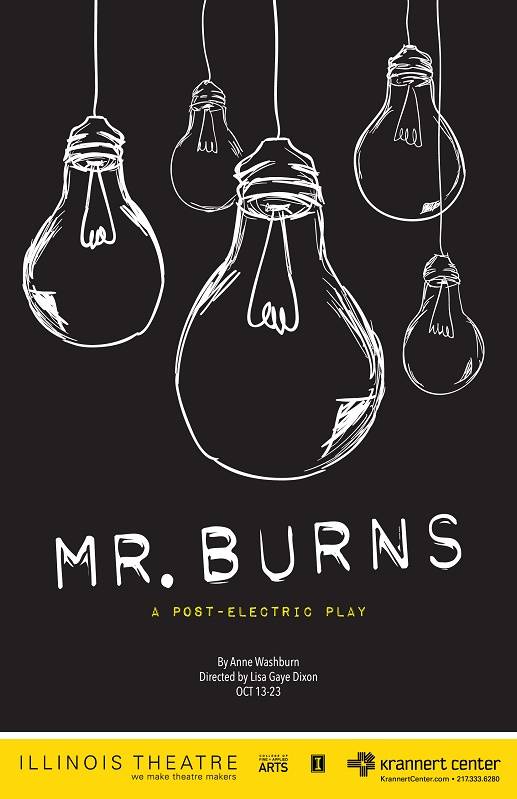
Mr. Burns, A Post-Electric Play is a satire set in a post-apocalyptic world written by Anne Washburn. Locked in a bank vault, a group of people try to entertain themselves by remembering bits and pieces of pop culture. However, they all settle on the modern cultural touchstone that is The Simpsons. Over time the memories and re-enactment of the “Cape Feare” episode of The Simpsons morphs and changes dramatically in a post-nuclear fallout world.
For those unfamiliar with the episode (ssn. 5, ep. 2), the “Cape Feare” episode is a memorable classic. Perennial nemesis Sideshow Bob attempts to murder Bart and his family in a parody of the 1991 film Cape Fear. The 1991 film is itself a remake of the 1962 thriller classic Cape Fear, which is based on the book The Executioners from 1957. You are also treated to Sideshow Bob (Kelsey Grammer) singing and visual nods to other thriller classics in the episode. With such deep layers in both the source material and the play itself, the play’s results are intriguing, a tad disturbing, thought-provoking, and, ultimately, entertaining.
As you can see, the play offers a lot to unpack about pop and visual culture so I contacted the director, Lisa Gaye Dixon, to ask a few questions. Dixon is a busy person. On top of being a director, she is also an Associate Professor in Theatre at the University of Illinois and an actor with beginnings in the Steppenwolf Theatre Company of Chicago. Recently, she acted in the independent film Leading Ladies and can be seen in the upcoming film Using. With so much experience, one can imagine how good a performance of Mr. Burns at the Krannert Center for the Performing Arts will be with Dixon at the helm.
———
 Smile Politely: This question is a fairly obvious one to start with: are you a huge fan of The Simpsons, a casual viewer, or a non-viewer? Were you familiar with the “Cape Feare” episode featured in the play beforehand?
Smile Politely: This question is a fairly obvious one to start with: are you a huge fan of The Simpsons, a casual viewer, or a non-viewer? Were you familiar with the “Cape Feare” episode featured in the play beforehand?
Lisa Gaye Dixon: I am indeed a big fan of The Simpsons. I was in grad school when I saw my first episode, so the absolute irreverence of it (along with having a mother who took me to see Blazing Saddles when I was 9), helped me to recognize my twisted sense of the world and my dark sense of humor [was] not alone in the world. It was nice knowing my ‘inappropriateness’ was shared. I am a casual viewer, in that I watch all the new episodes when I can, and watch many of the old ones on TV to wind down after a long day. I was familiar with the “Cape Feare” episode beforehand, and I had the entire cast watch it together early on in rehearsals.
SP: What is your directorial style? For example, are you hands-on with your cast or do you let them find their way? I noticed that you act as well so I’m wondering if that affects your approach as a director.
Dixon: I think you can be both hands on AND let the cast find their way — a director is, I believe, a guide of sorts, because s/he can see the entirety of the piece, whereas the actor must needs of course be deep inside the world of the play. As I am an actor by training, I tend to want to let, and to strongly encourage, my actors to play — to explore, to discover on their own — and then shape those results going forward. I value collaboration with actors — less hierarchical and hopefully more a shared experience, but it does change depending on the experience of the actor. I do not want someone to flounder; I don’t think that helps his/her process. Also, I am a very instinctual, very physical director: I am in/out of my chair, up onstage or in the space with the actors, mostly because they may make a choice that causes an impulse in my instinct, and that spurs my creativity and choice-making. I worry slightly about the possibility of my theatrical instinct failing me, but it hasn’t done so. Yet. My only philosophy: tell the truth — honor the character and the playwright. Leap off the cliff.
SP: Any funny or interesting anecdotes about preparing the cast and crew or yourself for the play?
Dixon: This play is weird enough that, really, everything is a bit beyond the pale. I do think the actors were way excited to know they would be watching episodes of The Simpsons as homework or in rehearsal work. How awesome is that?
SP: Mr. Burns, A Post-Electric Play has a post-apocalyptic setting from nuclear fallout. Did you find constructing a visual representation of the aftermath of this type of event relatively easy to construct?
Dixon: Well, all bets are off really, so I guess the answer is yes…and no. Because each act of the play moves forward in time, farther away from the now — and we move to a point where no one has actually ever seen an episode of the show but only enacts things from memories of others who are also past — we moved from the reality of a more naturalistic setting, toward a more ‘cartoon-y’ feel in the design aesthetic. Design is never easy, because you have to evoke a physical/sartorial world that is completely different yet completely recognizable.
SP: Mr. Burns is also a play about storytelling and how the re-telling of a tale over time can change but the story elements remain the same. The play also looks at how an element of pop culture can morph and become folklore or modern mythology. Does the play remind you of any others that tackle the idea of common visual/pop culture tropes or references? Or do you feel that the play is unique in this regard?
Dixon: HAMILTON! The characters (once real people) in that play were complete pop culture icons of their time, and are now nearly mythologized in the minds of many a theatre student nationwide. And actually, Hamilton has already crept into our lexicon and our everyday easy popular cultural references — so much so that EVERYONE knows what you are talking about when you refer to ‘the sisters’ or Lin-Manuel Miranda (there is even a reference to I in the show that we created but you’ll have to see if you can pick it out!). There is no doubt in my mind that Hamilton is the next generation’s Rent, Hair, or West Side Story…
SP: As a follow-up, did you find this aspect of the play easy to convey to audiences? Personally, I’m fascinated at how common tropes or cultural touchstones change depending on the viewer’s knowledge or exposure to it. For example, my brother didn’t get the My Fair Lady references in a Family Guy episode. That particular episode wasn’t funny to him until I explained the musical based on the play based on the myth of Pygmalion.
Dixon: It’s weird, we live inside pop culture now: it is less an idea than simply a way of conducting our daily lives. I notice that as I teach, I am constantly peppering my speech with pop culture references, so much so that sometimes I must try to stop myself, for fear of becoming some out of control commercial/inhuman advertisement — it is endemic to who we are now. And just as we sometimes live through social media avatars, in danger of disconnection from the self, we also live through the ideas of others, and take them in and incorporate them as our own. I only hope, and I try to instill this in my students — I only hope that we can always be certain of our own, individual core — that essential spirit that makes each of us uniquely ourselves—separate, different from, vibrant, alive in the truest sense. Because when we are, when we just… are, and then we come together-to create, to make art, food, love, buildings, whatever — the intermingling is simply, magnificently, human.
———
Mr. Burns, A Post-Electric Play will be at the Colwell Playhouse at the Krannert Center for the Performing Arts. Performances run from Thursday October 13th to Saturday October 22nd at 7:30pm and Sunday October 23rd at 3:00pm. There will be a talkback session on Thurs. Oct. 20th where audience members can ask questions about the performance, design, and themes of the play. More information and tickets can be found at the KCPA’s website, or by calling the Ticket Office at 217-333-2680.
Image of the poster is credited to the Krannert Center for the Performing Arts. Image of Lisa Gaye Dixon courtesy of the University of Illinois Department of Theatre biographical page.
Sarah Keim is a contributing writer for Smile Politely’s Arts section. She’s a bit of recluse on social media, but you might bump into her out in the wilds of C-U. Frequent sightings occur at farmers’ markets, movie theaters, and libraries.









 Sarah Keim is a contributing writer for Smile Politely’s Arts section. She’s a bit of recluse on social media, but you might bump into her out in the wilds of C-U. Frequent sightings occur at farmers’ markets, movie theaters, and libraries.
Sarah Keim is a contributing writer for Smile Politely’s Arts section. She’s a bit of recluse on social media, but you might bump into her out in the wilds of C-U. Frequent sightings occur at farmers’ markets, movie theaters, and libraries.